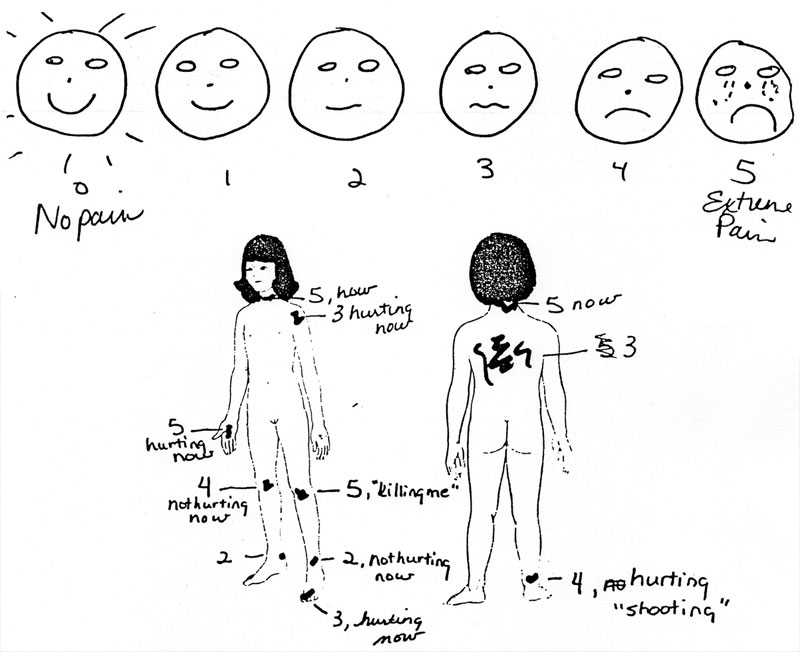Wong-Baker FACES History

Dr. Donna Wong and Connie M. Baker
The Spark of an Idea
The Wong-Baker FACES® Pain Rating Scale was created by Donna Wong and Connie Baker in 1983 to help children effectively communicate about their pain. Once practitioners clearly understood the child’s pain, they could develop a quality treatment and support plan.
In 1981, shortly after completing graduate school, Connie Baker began working as a child life specialist at Hillcrest Medical Center in Tulsa, Oklahoma. She worked with pediatric patients and their families to help them better cope with illness or injury.
Children often deal with their fears and concerns through play, where they can gain mastery over this new and often threatening hospital environment. This is a useful technique for reducing anxiety in both the children and their parents. Time showed this was a useful technique for reducing anxiety in both the children and their parents.
However, pediatric patients experiencing pain were so focused on their pain they could not participate in therapeutic play.
Connie observed that these children not only found it difficult to assess their pain but when they did, they were not believed. This, in turn, led to occasional lapses of effective care and treatment.
Early Research
During that time, Donna Wong, a legendary pediatric nurse consultant and one of the leading authors in pediatric nursing, became a consultant at Hillcrest Medical Center in Tulsa.
Connie and Donna met, and Connie expressed her concern about the children in pain. This was also of interest to Donna. They agreed that children needed a better method to communicate about pain so they could get the relief they needed. With the proper tools, children could participate in assessing their pain, leading to more success in overall pain management.
With the assistance of Peggy Cook, the hospital librarian, Connie and Donna learned everything they could about pain assessment and management. Through a thorough literature review, they eventually uncovered a few scales used with adults and some tools developed for children. Adapting a few of the adult scales and using the existing pediatric tools, Connie and Donna began introducing new assessment tools to patients.
Young children had considerable difficulty using any scale with unfamiliar words or scales based on numbering or ranking concepts. The use of the Numeric Rating Scale was growing in popularity at this time, but young children had trouble using the numbers. When children used a color scale, the color choices were not consistent with their peers, making the use of color challenging to replicate on a larger scale.
Faces and Tears
However, the children responded well to facial expressions. In hopes of creating a new assessment tool, school-aged patients were given a piece of paper with six empty circles, about the size of a quarter, in a horizontal line.
The children were asked to think back to their own experiences and draw facial expressions to show how they had felt when they experienced different levels of pain.
Children from the burn unit and the general pediatric unit readily participated and often created elaborate faces and hairstyles to demonstrate the gradation from “no pain” to “worst pain they could ever imagine.” Over 50 children participated.
Each child’s series of faces was unique, but a pattern soon developed in terms of the shape of the eyes, nose, and mouth. A composite of the most frequently drawn features became a part of a pilot introduction with a new group of 25 children to evaluate their ability to use the faces.

(Figure 1) An early sketch by a 13-year-old female patient
Initially, the faces received numeric ratings from 0-5, with 0 for no pain and 1 to 5 for increasing intensities of pain. It was essential to find the right balance between too many and not enough faces. Six choices were consistent with other scales used, which facilitated statistical comparison among the scales.
The preliminary results were favorable. Donna asked a professional artist to use that composite of faces as a guide, and he drew the final version currently used. The only additional, adult-determined detail, was to add more differentiation to the eyes and eyebrows.
The majority of the “worst pain” faces drawn by children included tears; even though many of these hospitalized patients did not cry when undergoing painful procedures, such as burn dressing changes. The children adamantly explained tears were necessary because “you could feel this bad inside.”
Tears remained on the scale, but instructions specify that tears do not need to be present when feeling the worst pain. Some have questioned having a smiling face in the face depicting no pain, arguing the face should be more neutral. A smiling face was what the children drew. Staying as accurate as possible to the children’s input, both a smiling pain-free face and tears were incorporated into the scale.
Even after the professional artist’s rendering of the scale, Connie continued to allow patients to create their own scales, by giving them a sheet of paper with six empty circles in a line. They created delightful, personal scales and proudly displayed them at their bedside and took them home for safekeeping and continued use should they need them.
Fine-tuning the Scale
To determine if children could use the scale to distinguish between different pain intensities, Connie asked children to mark their areas of pain on a drawing of a human figure then rate each area using the faces scale. Many of the children were burned on parts of the body more likely to be painful than others. This round of discovery showed that children quite accurately assessed pain intensity.

Figure 2) Connie Baker drew this quick sketch of the faces at a child’s bedside to help the child articulate pain using the human figure drawing.
Wong-Baker FACES® Pain Rating Scale is Launched
During the next research phase, Donna’s husband, Dr. Ting Wong, a chemical engineer and master statistician, became involved. He loved mathematics and, like Donna, was an excellent teacher. He devoted a great deal of time, creating a statistical structure for analyzing the data.
The initial series of systematic validity and reliability research of the Wong-Baker FACES® Pain Rating Scale (FACES Scale) took about two years to complete. In 1983, Connie and Donna began data collection, later assisted by Lynn Clutter, then a graduate nursing student. Now Lynn Clutter, PhD, APRN, CNS, CNE is the Vice President of our foundation board.
Data was gathered at Hillcrest Medical Center and St. Francis Hospital in Tulsa, as well as the University of California Davis Medical Center in Sacramento, where Connie later worked as a child life specialist. The FACES Scale was assessed along with an adaptation of the visual analog scale, and 4 other pain assessment instruments.
Most of the research subjects were children from preschool through young school-age (9-10 years of age). Because teenagers could use any of the adult scales, few adolescent subjects were invited to participate in the early work. It was thought that the idea of using faces to rate pain might seem too juvenile to adolescents
When the data analysis was completed on the comparison of the six scales, Donna and Connie discovered children in all of the age groups preferred the FACES Scale, even the adolescents! The details and results of that study can be found in the Resources section of the website, in the article Pain in Children: Comparison of Assessment Scales.
The primary goal for creating the Wong-Baker FACES® Pain Rating Scale was to help children effectively communicate about their pain so staff and parents could more successfully manage their pain. Initially, the numbers 0-5 were used to quantify the pain, but using the numbers 0-2-4-6-8-10 avoids confusion as it is more consistent with the numeric rating scale of 0-10.
The original instructions included a more detailed script. On this website, you will find abbreviated instructions, now recommended and included in the downloadable format. Drs. Lynn Clutter, Kristie Nix, and Donna Wong researched the change in instruction wording in 1995.
Current Use
Through the years, the Wong-Baker FACES® Pain Rating Scale grew in popularity and use around the world. Donna’s books, published by Elsevier Inc., were a significant reason for the wide-spread use. Also during this time, Donna earned her PhD.
Another Wong-Baker FACES Foundation board member, Pam DiVito-Thomas, PhD, RN, CNE and Dr. Donna Wong spent 5 years on an international and longitudinal study on three continents. That data was collated, but never written. We believed the data had been lost, until recently, when Dr. DiVito-Thomas found it on a flash drive! In 2003, former board member, Dr. Kristie Nix, joined with Dr. Donna Wong to research the use of the pain scale with adults.
Sadly, Dr. Donna Wong died in May of 2008, but her work lives on through the Wong-Baker FACES® Pain Rating Scale, her students and mentees, and her lifetime contribution in pediatric nursing, including her textbooks and countless articles. You may read more about Donna Wong in the About Us section of this website. Drs. Ting and Donna Wong’s daughter, Dr. Nina Wong Morrissette, an anesthesiologist, wife, and mother of two children, has joined the Wong-Baker FACES Foundation board.
In 2009, Connie Baker began the Wong-Baker FACES Foundation to continue the work of protecting the integrity of the scale, as well as promoting excellence in pain care. The Wong-Baker FACES® Pain Rating Scale has a registered copyright and trademark. People from nearly all countries in the world have visited this website. The scale is translated into over 60 languages, and the list is growing.
The FACES Scale was created with children for children and it remains widely used. The scale is supported by years of research, and it continues to be used in study around the world. However, time shows that the scale is valid for use with people of ages three and older, not limited to children. Other investigators have used the faces scale with adults, especially the elderly, with successful results. The cartoon-type faces scale avoids gender, age, and racial biases.
Connie Baker offers interviews with experts in pain care and atraumatic care on her podcast, FACES of Pain Care. She invites you to visit the page and subscribe to FACES of Pain Care.
Thank you for your interest in the Wong-Baker FACES® Pain Rating Scale. If you would like to contact us, please click on Contact to complete a brief web form. Someone will get back to you soon
